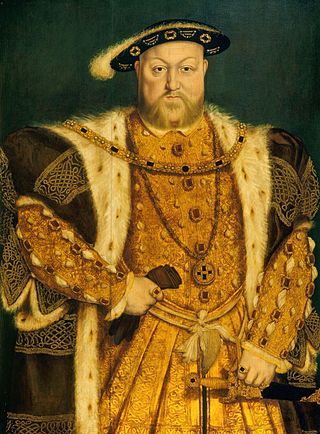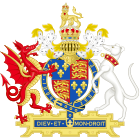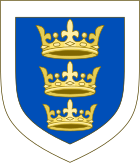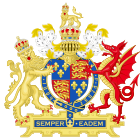
Henry VIII was King of England from 22 April 1509 until his death in 1547. Henry is known for his six marriages and his efforts to have his first marriage annulled. His disagreement with Pope Clement VII about such an annulment led Henry to initiate the English Reformation, separating the Church of England from papal authority. He appointed himself Supreme Head of the Church of England and dissolved convents and monasteries, for which he was excommunicated by the pope.
In English history, the penal laws were a series of laws that sought to uphold the establishment and State decreed religious monopoly of the Church of England against illegal and underground Catholics and Protestant nonconformists by imposing various forfeitures, civil penalties, and civil disabilities upon recusants from mandatory attendance at weekly Anglican Sunday services. The penal laws in general were repealed in the early 19th century during the process of Catholic Emancipation. Penal actions are civil in nature and were not English common law.

The Oath of Supremacy required any person taking public or church office in the Kingdom of England, or in its subordinate Kingdom of Ireland, to swear allegiance to the monarch as Supreme Governor of the Church. Failure to do so was to be treated as treasonable. The Oath of Supremacy was originally imposed by King Henry VIII of England through the Act of Supremacy 1534, but repealed by his elder daughter, Queen Mary I of England, and reinstated under Henry's other daughter and Mary's half-sister, Queen Elizabeth I of England, under the Act of Supremacy 1558. The Oath was later extended to include Members of Parliament (MPs) and people studying at universities. In 1537, the Irish Supremacy Act was passed by the Parliament of Ireland, establishing Henry VIII as the supreme head of the Church of Ireland. As in England, a commensurate Oath of Supremacy was required for admission to offices.

Caesaropapism is the idea of combining the social and political power of secular government with religious power, or of making secular authority superior to the spiritual authority of the Church; especially concerning the connection of the Church with government. Although Justus Henning Böhmer (1674–1749) may have originally coined the term caesaropapism (Cäseropapismus), it was Max Weber (1864–1920) who wrote that "a secular, caesaropapist ruler ... exercises supreme authority in ecclesiastic matters by virtue of his autonomous legitimacy." According to Weber, caesaropapism entails "the complete subordination of priests to secular power."

The Elizabethan Religious Settlement is the name given to the religious and political arrangements made for England during the reign of Elizabeth I (1558–1603). The settlement, implemented from 1559 to 1563, marked the end of the English Reformation. It permanently shaped the Church of England's doctrine and liturgy, laying the foundation for the unique identity of Anglicanism.

The Supreme Governor of the Church of England is the titular head of the Church of England, a position which is vested in the British monarch. Although the monarch's authority over the Church of England is largely ceremonial and is mostly observed in a symbolic capacity, the position is still relevant to the established church. As the supreme governor, the monarch formally appoints high-ranking members of the church on the advice of the prime minister of the United Kingdom, who in turn acts on the advice of the Crown Nominations Commission. Since the Act of Settlement of 1701, all Supreme Governors have been members of the Church of England.
There was no concept of "British history" in the 1500s, except that the word "British" was used to refer to the ancient Britons and the Welsh.

The Act of Supremacy 1558, sometimes referred to as the Act of Supremacy 1559, is an Act of the Parliament of England, which replaced the original Act of Supremacy 1534, and passed under the auspices of Elizabeth I. The 1534 Act was issued by Elizabeth's father, Henry VIII, which arrogated ecclesiastical authority to the monarchy, but which had been repealed by Mary I. Along with the Act of Uniformity 1558, the Act made up what is generally referred to as the Elizabethan Religious Settlement.

The Act of Uniformity 1558 was an Act of the Parliament of England, passed in 1559, to regularise prayer, divine worship and the administration of the sacraments in the Church of England. In so doing, it mandated worship according to the attached 1559 Book of Common Prayer. The Act was part of the Elizabethan Religious Settlement in England instituted by Elizabeth I, who wanted to unify the church. Other Acts concerned with this settlement were the Act of Supremacy 1558 and the Thirty-Nine Articles.

In England and Wales, the Tudor period occurred between 1485 and 1603, including the Elizabethan era during the reign of Elizabeth I (1558–1603). The Tudor period coincides with the dynasty of the House of Tudor in England, which began with the reign of Henry VII. Under the Tudor dynasty, art, architecture trade, exploration and commerce flourished. Historian John Guy (1988) argued that "England was economically healthier, more expansive, and more optimistic under the Tudors" than at any time since the Roman occupation.

The English Reformation Parliament, which sat from 3 November 1529 to 14 April 1536, established the legal basis for the English Reformation, passing major pieces of legislation leading to the break with Rome and increasing the authority of the Church of England. Under the direction of King Henry VIII of England, the Reformation Parliament was the first in English history to deal with major religious legislation, much of it orchestrated by, among others, the Boleyn family and Thomas Cromwell. This legislation transferred many aspects of English life away from the control of the Catholic Church to control under The Crown. This action both set a precedent for future monarchs to utilize parliamentary statutes affecting the Church of England; strengthened the role of the English Parliament; and provided a significant transference of wealth from the Catholic Church to the English Crown.
Although in the past the style of British Emperor has been (retroactively) applied to a few mythical and historical rulers of Great Britain, Ireland or the United Kingdom, it is sometimes used as a colloquialism to designate either Plantagenet and Tudor caesaropapism or, more frequently, the British sovereign of the Empire of India.

The Second Statute of Repeal or the See of Rome Act 1554, was an act of the Parliament of England passed in the Parliament of Queen Mary I and King Philip in 1555, followed the First Statute of Repeal of 1553. The first statute had abolished all religious legislation passed under Edward VI and the second statute built on it by abolishing all religious legislation passed against the papacy from 1529 in Henry VIII's reign. It did this while allowing Mary to keep the title of Supreme Head of the Church of England, a title which had been given to the monarch of England by Henry VIII's Act of Supremacy, passed in 1534. It was supported by the landed classes as it allowed them to keep the monastic land which they had acquired after the dissolution of the monasteries.

The Crown of Ireland Act 1542 is an Act that was passed by the Parliament of Ireland on 18 June 1542, which created the title of "King of Ireland" for monarchs of England and their successors; previous monarchs had ruled Ireland as Lords of Ireland. The first monarch to hold the title was King Henry VIII of England.
Events from the 1530s in England.

The title of Supreme Head of the Church of England was created in 1531 for King Henry VIII when he first began to separate the Church of England from the authority of the Holy See and allegiance to the papacy, then represented by Pope Clement VII. The Act of Supremacy of 1534 confirmed the King's status as having supremacy over the church and required the nobility to swear an oath recognising Henry's supremacy. By 1536, Henry had broken with Rome, seized assets of the Catholic Church in England and Wales and declared the Church of England as the established church with himself as its head. Pope Paul III excommunicated Henry in 1538 over his divorce from Catherine of Aragon.
The English Protestant Reformation was imposed by the English Crown, and submission to its essential points was exacted by the State with post-Reformation oaths. With some solemnity, by oath, test, or formal declaration, English churchmen and others were required to assent to the religious changes, starting in the sixteenth century and continuing for more than 250 years.

The English Reformation took place in 16th-century England when the Church of England was forced by its monarchs and elites to break away from the authority of the pope and the Catholic Church. These events were part of the wider European Reformation, a religious and political movement that affected the practice of Christianity in Western and Central Europe.
The Reformation in Ireland was a movement for the reform of religious life and institutions that was introduced into Ireland by the English administration at the behest of King Henry VIII of England. His desire for an annulment of his marriage was known as the King's Great Matter. Ultimately Pope Clement VII refused the petition; consequently, in order to give legal effect to his wishes, it became necessary for the King to assert his lordship over the Catholic Church in his realm. In passing the Acts of Supremacy in 1534, the English Parliament confirmed the King's supremacy over the Church in the Kingdom of England. This challenge to Papal supremacy resulted in a breach with the Catholic Church. By 1541, the Irish Parliament had agreed to the change in status of the country from that of a Lordship to that of Kingdom of Ireland.

The 1st Parliament of Queen Elizabeth I was ruled over by Queen Elizabeth I of England on 5 December 1558 and assembled on 23 January 1559. This Parliament would restore many of the laws created by Henry VIII and the English Reformation Parliament. Queen Elizabeth's 1st Parliament passed some 24 public statutes and 17 private measures by the time it was dissolved on 8 May 1559.















